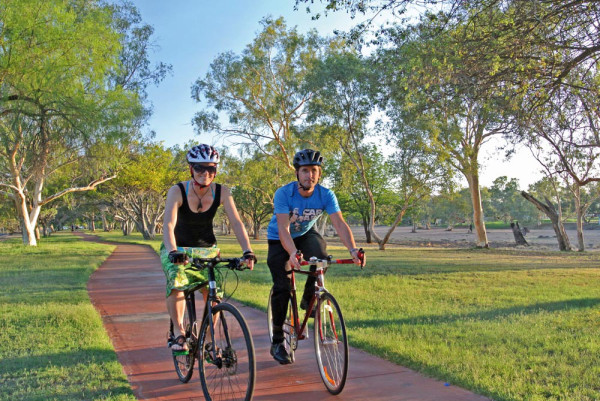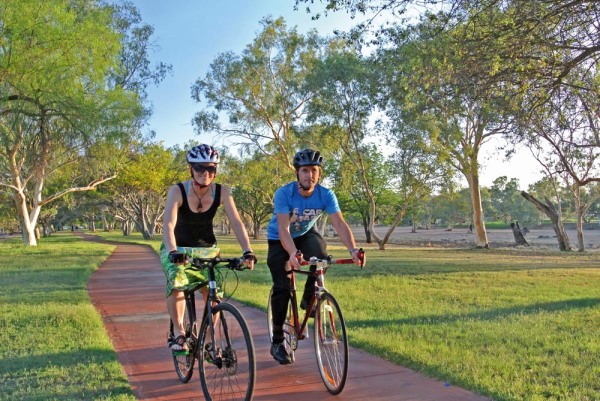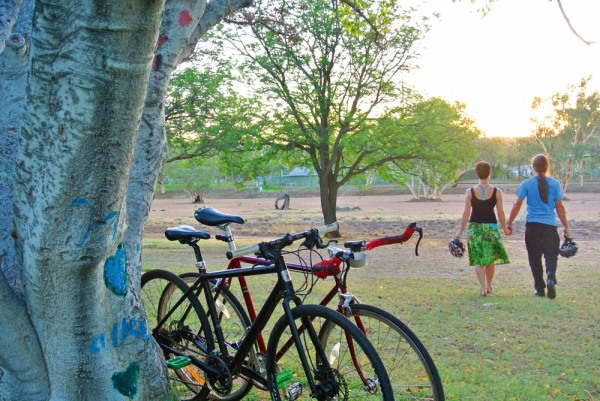First out of necessity and then for the love of it, Nic Learmonth knows how to live car-free. She shares her best advice.
When I first moved to Australia, I didn’t have the money to run a car. The move was a biggie in so many ways. I was suddenly in the midst of a city with more places to buy coffee than there were in my entire home country (New Zealand). Melbourne had about 3.9 million more people than the town I had left, too, so the size of the city and the sheer volume of traffic on the roads meant a huge change in pace and scale. But going car-free was no hardship; it was a planned adventure, a challenge to explore my new home on my own terms.
I bought an old wreck of a bike for $50 from a guy I met at a backpackers. That stubborn old clunker became my transport, my recreation and my connection with the city. I depended on it to be able to go food shopping, to get around and to get out of the house on weekends. Still new to the city, my partner Chris and I bought a street directory and went on rides through the burbs on Saturday and Sunday afternoons. We would stop for quick, cheap eats to keep the pedals turning. If we were in the city centre, our bike fuel of choice was a sushi roll each. Further afield, we might fuel up on samosa, fruit smoothies, souvlaki or Italian sorbet, depending on which part of town we ended up in.
The suburb we settled in was all about the bike. During peak hour, the roads through Brunswick are packed with bikes of every shape, size and genre. I didn’t like my old clunker, and that endless variety of bikes I saw on my daily commute into the city centre had me thinking about the bike I would replace it with. Could I pull off a narrow-barred fixie? Those retro step-throughs had style, but I like to go fast. Those proper road bikes looked fun, zipping by at speed, but I wasn’t sure I wanted to curl down over the bars every time I got on the bike. So what kind of a bike person was I?
A few months down the track, friends gave me an old Avanti road bike. It was a bit dinged up, with paint job of smokey grey twists spiralling up over a white background—straight from the eighties I loved it. I cleaned it up and added a new saddle, a brass bell and a pair of pedals I found in a bargain bin at Human Powered Cycles. The bike was a little too big, so I changed the drop bars for some flat bars and added a shorter head stem at CERES Bike Shed. While we were there, Chris found a chocolate-box purple and fluoro-yellow road bike and began some restorations of his own, eventually turning out a fully colour-coordinated singlespeed with flipped-bars.
Our new bikes shrank Melbourne down to even more manageable chunks. Being lighter, with skinnier tyres, these new steeds were much better suited to city riding. They seemed to glide over the smooth roads and bike paths, and they looked cool—but not so cool we worried about leaving them locked up outside the pub. They seemed to reflect the kind of riders we were: practical and up for anything.
Chris and I were still car-free, so our bikes were still our only form of transport, but not every ride we took was a long one. Sure, I rode everywhere I needed to go— to work and back, to go food shopping and to the rock-climbing wall. But the bike was becoming part of me. The clothing I put on each morning was chosen around how it would perform on the bike and the conditions I expected to encounter on my ride. I started wearing my trouser legs rolled halfway up my calf—it started as an oversight and then became a trademark. And I rode my bike to destinations that were well within walking distance: Chris and I took turns at finding bars near work for Friday nights out and cafés within 10 minutes’ ride from our place for Saturday morning brunches, just for the pleasure of taking the bikes out, of going out for a spin.
Our friends who did not ride were fascinated. When we’d meet up for dinner on Lygon Street or over in St Kilda, they had to check. “Did you ride here?” they would ask as I pulled off my cycling gloves and Chris stowed his lights in his bag. They couldn’t see how Chris and I could get by without a car; I couldn’t see why they were missing out on all the fun—the pedal home through the darkened streets was one of the highlights of my night out.
We lived in Melbourne for two years without a car and then moved to Alice Springs, where we now live in a two-bedroom apartment with seven bikes. We now own a car, which we use when we need to deliver a bike to our bike mechanic.
For people thinking of going car-free, or even using their bike more, Nic has some sage advice from her experiences.
Finding your way
Not every ride has to be on the main roads. I looked for cycling maps that showed cycling paths and quiet roads as well as main streets, and planned routes that took me down alleyways, along rivers and through parks. As we got settled, Chris and I started plotting our routes to work around café stops. We’d duck in, grab a coffee each and put it into the coffee cup-holders on our handlebars.
Gear up
If you’re not driving a car, you don’t have to pay for fuel, car rego and insurance, parking and mechanics’ fees to keep that engine running. So drop some money into things that will keep your riding fun. Don’t just get a helmet that fits; get one you like wearing, because you are going to be wearing it every day. Lights, a rain jacket and bike gloves are the other essentials. There are so many schools of thought when it comes to choosing these things. Some people like small and light, others want durable and hard-wearing. Chris is into stylish, heavy-duty metal object d’art-type lights. But I like my around-town lights small and compact, so I can slip them in my pocket when I’m off the bike. It all comes down to what is going to work for you.
Learning to live with a bike
The heavy versus light debate seems to rage whenever bikes and cycling gear come up. My urban bike was pretty light, and that was a good thing because I had to throw it over my shoulder and carry it up and down flights of stairs at work and to get to and from my first-floor apartment, and I’m not a very big person.
Living in a single-bedroom apartment with two town bikes and two mountain bikes (which we soon acquired) meant Chris and I had to organise our furniture around where we parked the bikes. Sometimes our town bikes lived outside, on the lockable balcony, but mostly we kept them inside the apartment. Because we were nipping in and out a lot, we usually just leaned our town bikes against the wall by the front door. If we were expecting visitors, we moved them to a vertical bike parking rack that stood against a blank wall in the kitchen. Bikes feel like art to me, so I quite liked the way the bikes were displayed on our floor-to-ceiling rack, and it kept them out of the way.
Carry what you need
I keep telling myself there’s a bag out there that will do it all: it will fit all the gear I need for the day, it will be waterproof, it will have an outer pocket for my lights and lock key, it will sit well when I’m pedalling flat-stick, it will fit my laptop and it will have space for my groceries and that bunch of coriander and the 1kg bag of potatoes I need to pick up on the way home. And it will be a suitably small and hipster-cool bag.
Until I find that bag, I keep rotating the collection. I have a small satchel for just my sunnies, phone and wallet; a hydro-pack for long rides; two over-the-shoulder messenger-style bags for trips to the café; a backpack for work clothes, a rain jacket and my lunch; a larger canvas backpack for shopping runs; panniers for bigger shopping trips; and a score of plastic bags and water-proof stuff sacks I use to protect my wallet, phone, laptop and anything else I will be carrying that I want to keep dry.
Cut yourself some slack
Bikes need fuel too. If you’re on the bike and starting to fade, stop and get something to eat. Sushi is my favourite bike fuel, but if things are feeling desperate, a chocolate bar will have those blood-sugar levels back to where you need them very fast, so you can get back on the bike.
Sometimes, you need to cut yourself some slack. Because sometimes you have the worst day at work. Or sometimes the winter weather is just too much. Or you feel a bit off-colour, or forget to carry a spare tube and repair kit. Sometimes you want to dress up in clothes that just won’t work on the bike.
Going car-free doesn’t mean you have to make every trip by bike. Give yourself some outs. Get yourself a public transport pass and put it in your wallet for that day—or night—that you just can’t face riding home. Put your favourite taxi company into the contact list on your phone. And if you have to make some trips by car, consider joining a car-share scheme so you have affordable access to wheels when you need them.
Nic Learmonth is a Kiwi mountain biking and cycling writer and editor. You can read Nic’s work in Australian Mountain Bike, Flow, Spoke and The Climber magazines and on easterinthealice.wordpress.com.
Ride On content is editorially independent, but is supported financially by members of Bicycle Network. If you enjoy our articles and want to support the future publication of high-quality content, please consider helping out by becoming a member.




One thought on “1”